A few weeks ago, our friends at Grassroots Motorsports Magazine held their annual festival of affordable speed insanity, the $2017 Challenge, which is held every year at the Gainesville Raceway in Gainesville, Florida. For those not in the know, this contest pits cars against each other in three events: Autocross, Drag Racing, and a car show they call the Parc Exposé . And the best part: you have to keep your budget under the dollar amount of the year the event takes place, save for safety equipment and one set of tires. It’s an honest budget speed contest that remains one of the most exciting events on the calendar every year. And nearly every year, you can count on PACC Racing to show up with some truly impressive rides built for pennies on the dollar.
The “PACC” in PACC Racing is a fancy acronym for the Nelson Family (mom Paula, dad Andrew, and sons Calvin and Cameron). We’ve mentioned these guys before, as they usually bring some of the coolest, fastest hardware to the GRM Challenge and other budget events. Dad Andrew regularly aims to set the record for the fastest pass in the 1/4 mile portion of the event, firing off a 10.263 second pass at the $2016 Challenge with their famed, bright yellow VolksRod. This year, they set out to beat themselves in a ride that has been over a decade in the making: a nasty, stretched wheelbase 1974 Datsun 260Z they dubbed The SR-71D. After about a decade of design and building, and after a few broken engines, the car clicked off an unbelievable 9.52 second pass
In traditional BangShift fashion, let’s get straight to the pictures!

This car actually debuted at the $2006 Challenge as a V8-swapped Datsun Z running a Small Block Chevy. These cars can get squirrelly at high speeds, and that’s without the added power of a V8. After the car’s Challenge debut, Andrew decided to re-build the car for land-speed racing, so elongating the nose was a way to get the car to stay stable at high speeds. When the Nelsons decided to switch the car back to GRM Challenge duty, having the longer nose would prove to keep the car more stable on the 1320.
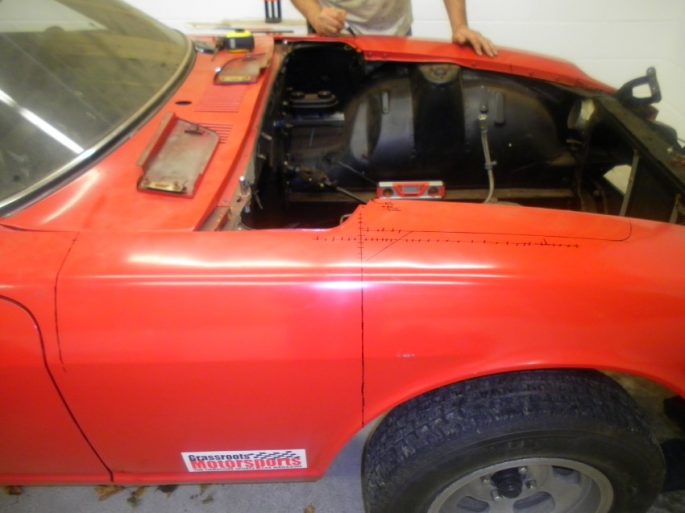
Measurements were taken, and plans were made to stretch the nose of the car to make sure this thing stays on the ground at high velocity. It’s not as easy as cutting and adding more bodywork; the entire front subframe and suspension needed to be redesigned to make it all work.
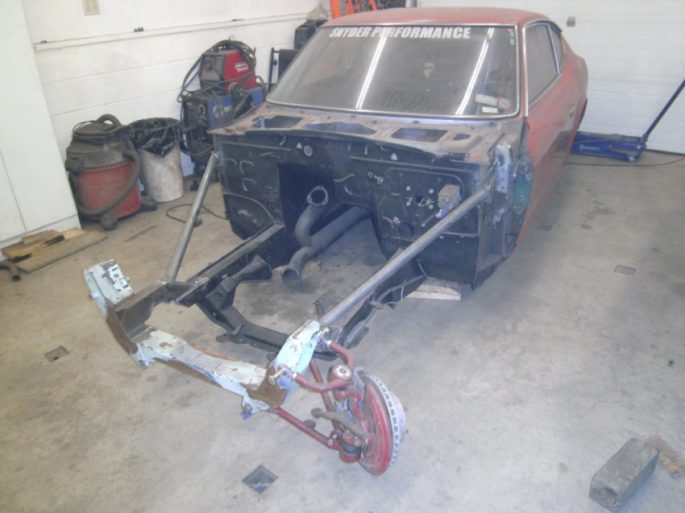
This pic is just the beginning of the modifications. The subframe needed to be stretched, extra bracing needed to be added, and a new home for a V8 needed to be built.

Here’s a rough approximation of where things would end up under the extra long hood. The engine is just mocked up at this point, but you can see how far it’s set back compared to where the front of the car will be.
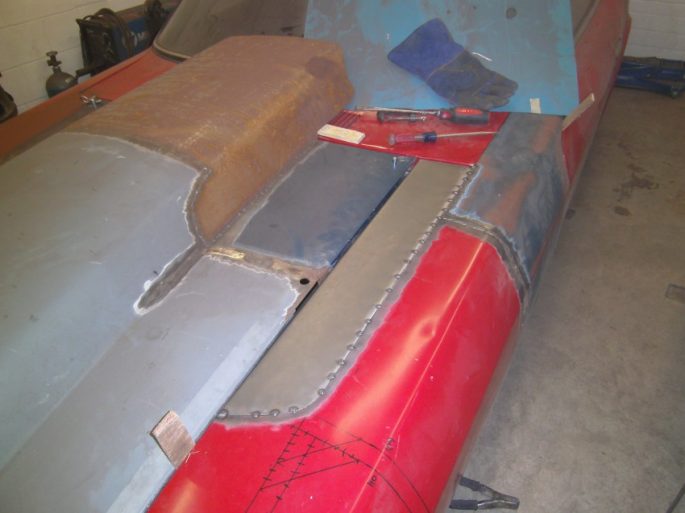
Here’s a good pic that shows just how much more they added to the front of the car. That “wing” on the fender is extended well over a foot! On a stock Z, they open up, allowing access to the master cylinder and battery, but on this car they were just added to the fender.
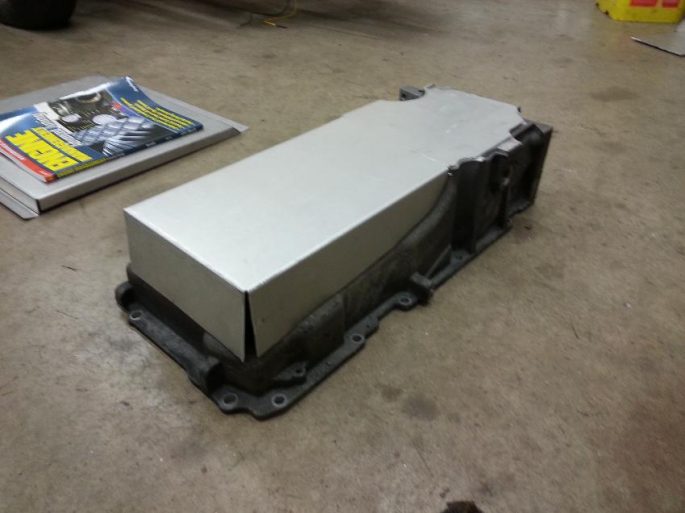
Custom oil pans are expensive. Making one yourself by combining a stock one with some salvaged material is not!

The Nelsons were running consistently in the 10’s with relatively simple Small Block Chevy builds with a bit of the spray tossed in for good measure, but if they were going to break the 10-second barrier in a sub-$2000 build, a honkin’ turbo is a good way to get there!
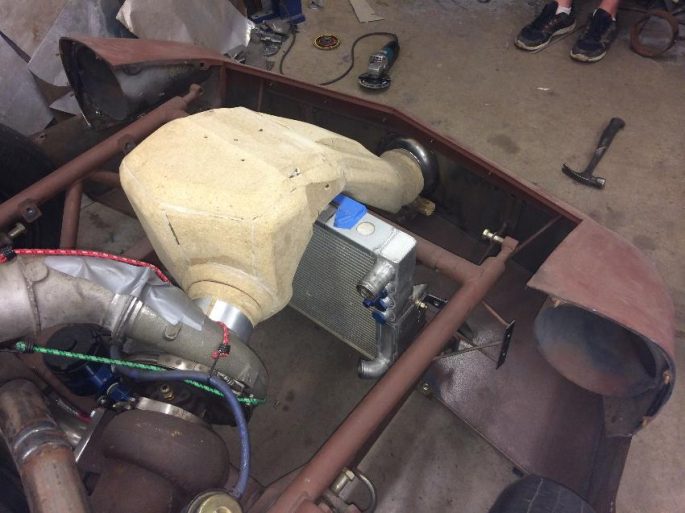
That weird looking sawdust tumor is actually a mocked-up airbox. It feeds right from a central inlet on the front bumper.

Speaking of that hole in the bumper, here’s a mock-up of the front bumper assembly. Note the molded-in headlight covers and that huge front valance to help the direction of airflow.

Here, you can see that it’s starting to look like a complete car again. Note that this entire front end is temporary. You’ll see why in a bit.

Also, here’s a better approximation of where the mechanical bits will end up under the huge hood. Looking good!
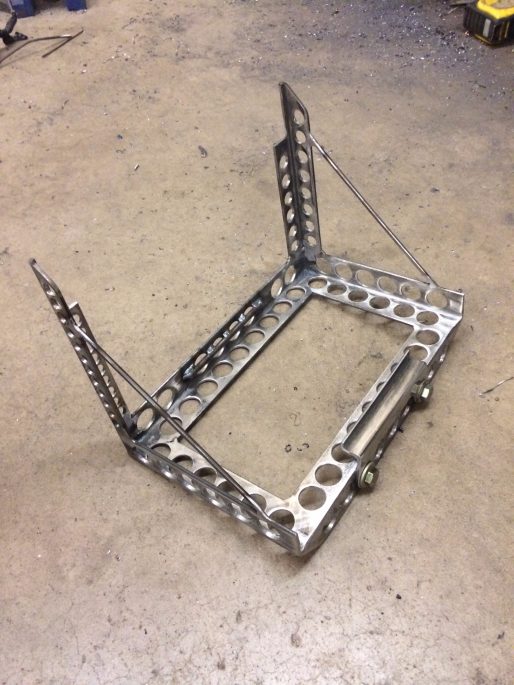
Ever hear that old racer adage “Add lightness”? The Nelsons apply that mantra to everything they build. I once had a conversation with Andrew where he was going down a mental list of items he modified or replaced on a build, like switching to shorter accessory belts and swiss cheesing non-essential parts, just to save a few pounds. This part is a battery bracket, and you can see the attention to detail in keeping things light, even on mundane parts you wouldn’t even think about. It all adds up!

Speaking of lightness, they molded the entire nose of the car in fiberglass to keep weight down. Very cool.

And here’s the fiberglass front end on the car, ready to rock. The hood was also made of the same material.
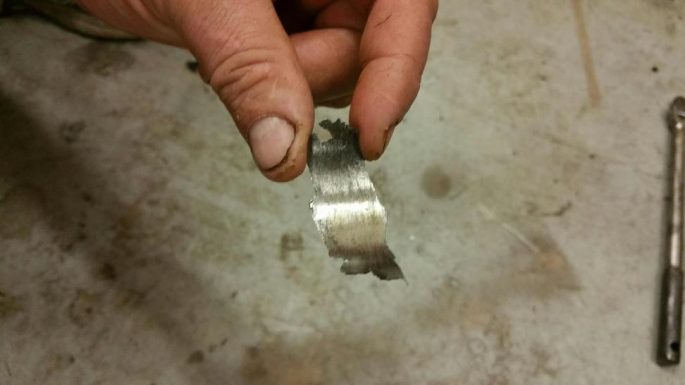
Now, building a budget car for this type of speed contest isn’t going to happen without some trial and error. The car in it’s original form was running a traditional Small Block Chevy, and they switched to turbocharged Gen III Chevy power for the rebuild of the car. Picked up on Craigslist on the dirt cheap in unknown condition, they would stab one in and hit the track. They went through a few of those, grenading them all before switching back to traditional SBC power with lots of nitrous in lieu of boost. Even then, they had some failures!

Cheap engines don’t have the budget room for custom pistons, so they hit flea markets and swap meets for used race parts on the cheap. The pistons they put in the final engine in the car were kissing valves, so they busted out a belt sander to clearance them! Is it fancy? No, but it definitely works!

And here it is, ready to blast down the track in it’s final form. Note that the air inlet that used to go to the throttle body now feeds a custom ram air scoop straight to the carb. Not quite what they intended at the beginning of the build, but the proof is in the numbers… it works!
And of course, there’s footage of the historic pass. Check it out below:
Going that fast for this cheap is truly an accomplishment. Having helped build a few different cars for this event myself, this is one of the only “budget cap” events that really adheres to the actual, real-world budget. You get a free set of tires and some safety equipment as exemptions, and that’s about it. Parts have to come from public offerings, like Craigslist, eBay, or swap meets, and free stuff has to be open to everyone in a public venue, so no sweetheart deals or sponsored/donated stuff. It’s not easy to build a car like this. You’ll find yourself going as far as picking up bits of exhaust that fell off someone’s vehicle on the side of the highway or cutting up a free washing machine for sheet metal to make ends meet. And let’s face the facts: while the Small Block Chevy is about as rare in a race car as water is in the ocean, making a car powered by anything hustle down the track this fast for a real-world investment of around $2000 is not easy. 9.5 seconds in a car that you built yourself in your garage that’s basically made out of discarded scraps is impressive in our book, and it’s 100% Bangshift Approved!
The PACC crew documents all their builds on their website, which you can find HERE. there are TONS more pics of the build there, as well as some of their other projects. Check it out!













Very cool ,and family built also very cool .All that for $2017.00 ?
I’m all for these budget challenges as they push the creative envelope. But they are getting out of hand for what they are trying to pass off as $2000 builds. Between the ls, turbo, radiator, the car, and everything else it takes to build a car. Factor in fuel lines, fittings, and fluids.
I mean cheap is great but lets call a spade a spade.
I agree – this is more than a $2K modification.
I’m in agreement and calling Shenanigans on this one. There are obviously rules and loop holes in play that allow a net finished value of 2k. Post the accounting on this one and convince the non believers
Factoring in the safety equipment that cannot be fabricated that is a requirement for a 9 second ride. SFI flex plate ($60) , trans shield ($200), flex shield ($80), balancer ($200), belts ($120)) and you’ve eaten up more than a 1/4 of the 2k budget. Even the cost of the raw materials to create the new sub frame and a 9 sec. spec roll cage is another 1/4 of the budget. Do we even start talking tires, shocks and drive-line that can safely handle a 9 second pass and run the autocross ?
I have never been a fan of these capped budget events as there will always be the team that has an unfair advantage of talent, tools or the “free” pile of stuff sitting in the corner or donated or ???
Of course I just read the rules and some of point is off
The Reese Rule: SFI-approved harmonic balancers, SFI-approved flywheels and SFI-approved flex plates are budget-neutral.
Some non rotational parts are also exempt
These safety items are budget-exempt: seat belt or harness; fire extinguisher; roll bar padding; wheel lugs, studs and bolts, and four tires. Brake friction materials, lines, calipers, master cylinders, rotors and drums may be replaced with fresh ones that are functional duplicates.
But some are not…
SFI-approved transmission shields, SFI-approved flex plate shields, and SFI-approved bell housings are not rotating parts, and are not budget exempt.
More basis for calling Shenanigans
Any inside deals—parts, whole cars, trades, donations, stolen parts, etc.—must be added to the budget at fair market value.
Since you can sell parts off the car up to the value = 1/2 the total budget the racers actually have 3,025.50 to build the car.
If you spend that much money on parts that you listed, you can\’t possibly comprehend building a budget project, let alone one with a defined budget. First, half the parts listed are exempt in the rules. Second, the ones that do count are way higher then they should be if you were budget focused.
I got $20.00 saying that can’t do that with a Studebaker 6 cyl or Packard 8 cyl engine for $2000.00.
anybody and I mean anybody can go to 7-11 and buy chebbie parts to go fast. using the brain to do it with another engine is another matter.
we need a survey. who is tired of chevy’s, ford’s and mopar’s and would like to see other engine make go fast????
I’m with ya,how about a Rambler 196 .I am LS’d to death .
No way 2k
Kudos to these guys. In this case time isn’t money. Maybe they should have their own TV show. Would beat the hell out of Gas Monkeys and Street Outlaws. I likey aloty. Hot rodding the way it should be. Thank you Tones for this story.
Agreed. Guys who build cars with tons of labor are not appreciated enough,
As I always have said when all the non believers come out, go to a GRM $20XX Challenge some time. After talking to the competitors you’ll realize how much you can learn from a budget builder. It’s not about the money you spend pulling brand new parts off the shelf of your local speed shop. Anyone can do that. These guys actually BUILD these cars. Lots of used parts, repurposed parts, and duct tape lol
PACC is as legit as they come and they have the most detailed budget books you’ll find. It’s an insult to hear you talk about them as any less than awesome.
Know the car. Know the folks. Seen the budget. Legit for the rules of the competition. He knows what he has in it without the exemptions. It was still under $2500. Read the rules. They bought drag slicks for their exempt set of tires.
Here\’s a video of the pass, with his full budget listed in the comments:
https://www.facebook.com/grassrootsmotorsports/videos/vb.66381183139/10155860451043140/?type=2&theater